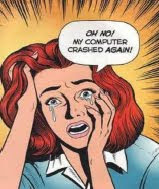If your disk-image backup program hangs or crashes, or you have other reasons to believe a disk is corrupt (power failures, etc.), run a DOS check disk (chkdsk). This command will more thoroughly repair the disk than the default Windows-based error-check routines.
Steps:
A check disk will take approximately 1.5hrs, depending on the size of the disk. It will spend a huge amount of time at 28%, be patient.
1. Launch an Administrator DOS Prompt
Windows 8
a. From the Start Page, swipe from bottom or "other-mouse-click" background
b. Click "All Apps"
c. Locate "Command Prompt"
d. Other-mouse-click Command Prompt icon; choose "Run as Administrator"
Windows 7
a. In the Start Menu, locate "Command Prompt"
b. Other-mouse-click menu item, choose "Run as Administrator"
2. Type this command:
chkdsk C: /f /r (enter)
With the C: drive, DOS will complain the disk is in-use ("volume in use")
Acknowledge the prompt with "Y".
Nothing else will happen.
3. Close the DOS window by typing this command: exit
4. Gracefully reboot / restart the computer.
The CheckDisk will start when the machine boots.
Go out and have a nice dinner.
When done, it will automatically load Windows.
Review the Results:
Windows 7 and Windows 8 may not show the results of the scan, especially if no errors were found. Optionally confirm what Chkdsk found by looking in the Application Event Log.
5. In Control Panel, Administrative Tools, "Event Viewer"
Open Windows Logs, Applications
Click "Filter"
In Event Sources, type "chkdsk"; Click OK
Review the events.
Within each found event, note the two tabbed items below.
Scroll down to read the reports.
What you want to see is a report similar to this:
Windows has scanned the file system and found no problems.
No further action is required.
:
0 KB in bad sectors.
:
Anything else may be cause for concern; see below.
6. With File Explorer, examine the root directory of the scanned disk (C:)
Look for chkdsk log files with names similar to this:
Chkdsk20120703093010.log
If found, these are recovered damaged files but are likely not useful.
Examining (with Notepad) and you will probably find they are useless and can be
deleted.
What if Bad Sectors / Bad Clusters are Found?

A few (hundred) bad sectors is not the end of the world, but does indicate some kind of hard disk trauma or power problem. As Chkdsk runs, it marks bad clusters and takes them out of rotation. Rarely, viruses will damage clusters but most do not do this anymore - a killed host can't propagate the virus.
If you find a larger number of chkdsk log files and the Event Viewer shows a large number of errors, Reboot and run these steps again. If errors continue, your disk is failing. Manually copy important files to separate media and replace the drive, or if you are like most people, buy a new computer.
Times like this are a good time to take an image of the disk, but the image may fail if clusters are misbehaving. This can be a scary time. See this keyliner article: Acronis Step-by-Step.
Related Articles
Acronis Step-by-Step
Disk Image Cleanup Steps
USB Backup Drive Slow
Frankenputer comics





No comments:
Post a Comment
Comments are moderated and published upon review. (As an aside, not a single spam has been allowed through; why bother?)